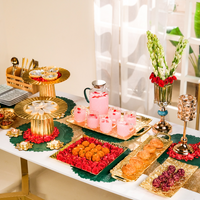Maintaining a hygienic kitchen goes beyond just keeping countertops and floors clean. The tools and utensils you use daily are also crucial to a safe cooking environment. Properly cleaning your cooking utensils not only ensures they remain in good condition but also helps prevent cross-contamination and foodborne illnesses. In this blog, we'll share some effective cleaning hacks and tips to keep your kitchen tools spotless and ready for your next culinary adventure.

Tips On How To Clean Cooking Utensils
Cleaning Specific Types Of Utensils
A. Cleaning Pots And Pans
1. Stainless Steel Pots And Pans: To remove stubborn stains, fill the cooking pot with a mixture of equal parts water and vinegar, bring it to a boil, and then scrub with a non-abrasive sponge. For burned-on food, sprinkle baking soda over the wet surface and scrub gently.

2. Nonstick Cookware: Avoid using metal utensils or abrasive scrubbers that can damage the nonstick surface. Instead, use a soft sponge and mild dish soap. For tough residues, soak the pan in warm, soapy water for about 30 minutes before cleaning.
Explore: https://nestasia.in/collections/bakeware

3. Cast Iron Skillets: Rinse the cast iron skillet with hot water immediately after use, then scrub with a brush. Avoid soap, as it can strip away the seasoning. After cleaning, dry thoroughly and apply a thin layer of vegetable oil to prevent rust.

B. Cleaning Knives And Cutlery
1. Chef’s Knives: Hand wash knives immediately after use to prevent rust and corrosion. Use warm, soapy water and a soft sponge. Avoid soaking knives or placing them in the dishwasher. Dry them immediately with a towel.

2. Cutlery: Most stainless steel cutlery can be cleaned in the dishwasher, but hand washing is often gentler. For tarnished cutlery, use a mixture of baking soda and water to polish.

C. Cleaning Wooden Utensils
1. Basic Cleaning: Wash wooden utensils with warm, soapy water and dry them immediately to prevent warping. Use a scrub brush or sponge to remove food particles.
2. Deep Cleaning: For stubborn odours or stains, sprinkle coarse salt on the wooden surface, then rub with a half-cut lemon. Rinse and dry thoroughly. Regularly apply a food-safe mineral oil to maintain the wood’s condition and prevent cracking.

D. Cleaning Silicone Utensils
1. Basic Cleaning: Silicone utensils are dishwasher-safe and can handle high temperatures, making them easy to clean. Simply place them in the dishwasher or wash them with warm, soapy water.
2. Removing Stains: For stubborn stains, soak the silicone in a mixture of baking soda and water. After soaking, scrub with a sponge and rinse well.
Also exlpore: https://nestasia.in/collections/moulds
![]()
Cleaning Tips And Tricks
A. Dishwashing Soap Vs. Natural Cleaners
1. Dishwashing Soap: Effective for removing grease and general grime. Choose a mild, non-toxic soap to avoid leaving harmful residues.
2. Natural Cleaners: Lemon juice, vinegar, and baking soda are excellent natural alternatives for cleaning and deodorising. They’re effective, eco-friendly, and often more gentle on surfaces.

B. Scouring Techniques
1. Non-Abrasive Scrubbing: Use non-abrasive sponges or cloths to avoid scratching surfaces. For tougher stains, baking soda can be used as a gentle abrasive.
2. Avoid Harsh Chemicals: Strong chemicals can damage utensils and leave harmful residues. Stick to mild, natural options whenever possible.

C. Removing Food Odours
1. For Utensils: Soak utensils in a mixture of water and vinegar or lemon juice to neutralise odours. Baking soda can also help absorb and eliminate smells.
2. For Cutting Boards: After cleaning, rub the surface of the wooden cutting board with a lemon slice or a mixture of salt and lemon juice to remove odours.

Conclusion
Keeping your cooking utensils clean is essential for a hygienic kitchen and for ensuring the longevity of your tools. By following these effective cleaning hacks and tips, you can maintain your utensils in top condition and create a safer cooking environment. Whether you're dealing with stubborn stains or everyday grime, the right cleaning techniques can make all the difference. Happy cleaning!





















